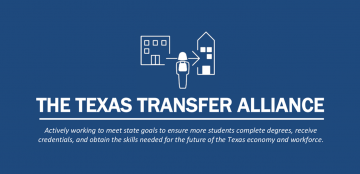
Essential Practices to Improve Student Transfer: A Call to Action from the Texas Transfer Alliance
Below is an excerpt from an open letter to stakeholders in Texas institutions of higher education. Download the complete letter (PDF), which includes useful examples of steps Texas institutions are taking right now to drive progress on transfer in the face of COVID-19:
DOWNLOAD FULL LETTER
To Our Colleagues at Texas Institutions of Higher Education,
The Texas Transfer Alliance—a joint effort between the Charles A. Dana Center, the Texas Association of Community Colleges, and four of the state’s public university systems (Texas A&M University System, Texas State University System, University of North Texas System and The University of Texas System)—was formed in late 2018 out of a shared belief that we need to collaborate across the state if we are to make meaningful progress on transfer student outcomes. We set ambitious goals for our work (see sidebar elsewhere on this page) —focused on closing equity gaps—that have taken on increased urgency as the health, education and workforce impacts of COVID-19 have disproportionately affected low-income communities and people of color, and as a national movement toward racial justice has, hopefully, taken root in new ways.
As we look to the recovery from COVID-19, the members of the Texas Transfer Alliance feel confident of one thing: we can expect more Texas students to transfer across our institutions—in multiple directions, within and across the 2- and 4-year sectors—than ever before. At the same time, our nation is grappling with its history of racial injustice. Calls for systemic change demand a hard look at practices and policies in higher education, such as transfer, that continue to produce inequitable student outcomes by income, race and ethnicity.
Now is the time to lean into conversations on and strategic planning for transfer. In response to the exemplary work underway across both regional transfer partnerships and systems, and informed by research on essential transfer practices, the Texas Transfer Alliance has identified the following promising practices for Texas institutions to consider:
Prioritize Transfer:
- Name transfer as a key priority within your institutional strategic plan and COVID-19 response plan, analyze your data to understand current transfer student outcomes vis-à-vis the 2025 Goals of the Texas Transfer Alliance (see goals on page 1), and communicate to your community that improved credit transfer and applicability are critical to supporting recovery from the pandemic;
Create Clear Pathways for Students:
- Identify and clearly communicate a set of courses in high-volume majors that, if taken elsewhere and/or remotely during the COVID-19 response period, will be applied to meeting requirements for program completion upon transfer;
- Develop and formalize dual admissions agreements that clearly map student pathways and guarantee applicability of credit upon transfer;
- Ensure that degree program requirements and transfer equivalency tools are up-to-date and highly visible to students to make it easy to understand transferability and degree applicability;
- Examine and consider expanding prior learning assessments and credit by examination policies and ensure that information on these policies and processes is easy for students and community college advisors to find and understand;
Provide Tailored Student Services and Advising that are Responsive to COVID-19 Exigencies:
- Strongly recommend and communicate clearly across the institution that courses completed under an alternative grading basis (e.g., pass/no pass) due to COVID-19 should be accepted for transfer admissions and applied to general education or program-specific requirements;
- Build in additional flexibilities within transfer admissions and enrollment processes, wherever practical, and clearly communicate changes to students and families, including changes to application deadlines, fees, and minimum entrance requirements;
- Work with your transfer partners to ensure advisors and financial aid officers have the best information available, are prepared to guide students, and are seeking to minimize the bureaucratic burden on students;
- Streamline processes to assure registrars manage and issue transcripts in a timely manner and explore processes and technology that expedite transcript issuance; and
- Examine institutional residency requirements to reduce barriers to degree completion for transfer students who are close to completion.
We know that much is being asked of you right now. The COVID-19 crisis and its impact on colleges and universities have been overwhelming. But ensuring we are ready for the wave of student mobility coming, and laser-focused on ensuring equitable student outcomes, is essential to our long-term sustainability and our students’ futures. Supporting Texas students and bringing displaced workers back to higher education for further skills training will require a keen focus on improving credit applicability upon transfer. We appreciate your hard work, steadfast commitment to students, and attention to the urgency of this matter.
Sincerely, the members of the Texas Transfer Alliance (in alpha order),
Martha Ellis
Interim Managing Director
The University of Texas at Austin, Charles A. Dana Center
Jacob Fraire
President and CEO
Texas Association of Community Colleges
Rosemary Haggett
Vice Chancellor for Academic Affairs & Student Success
University of North Texas System
James Hallmark
Vice Chancellor for Academic Affairs
Texas A&M University System
John Hayek
Vice Chancellor for Academic & Health Affairs
Texas State University System
Rebecca Karoff
Associate Vice Chancellor for Academic Affairs
The University of Texas System
Download the complete letter (PDF), which includes useful examples of steps Texas institutions are taking right now to drive progress on transfer in the face of COVID-19:
DOWNLOAD FULL LETTER
About the Author
Martha Ellis
I was a first-generation college student. Going to college changed my life, thanks to wonderful faculty and learning about disciplines I had no idea existed. For this reason, I have worked in higher education for almost my entire career. I have a deep respect for students and faculty, and I know that education changes lives.
Get in Touch
We collaborate with states, districts, and teachers to develop innovative curricula, resources, and professional development.

